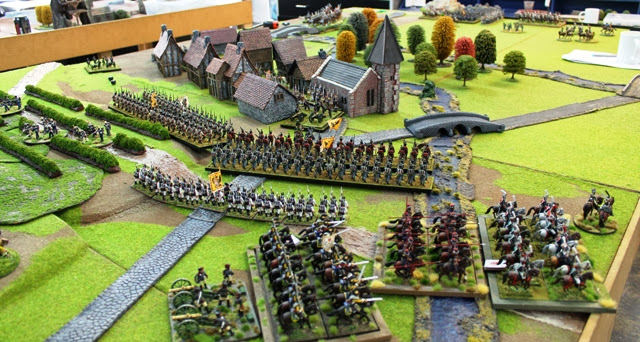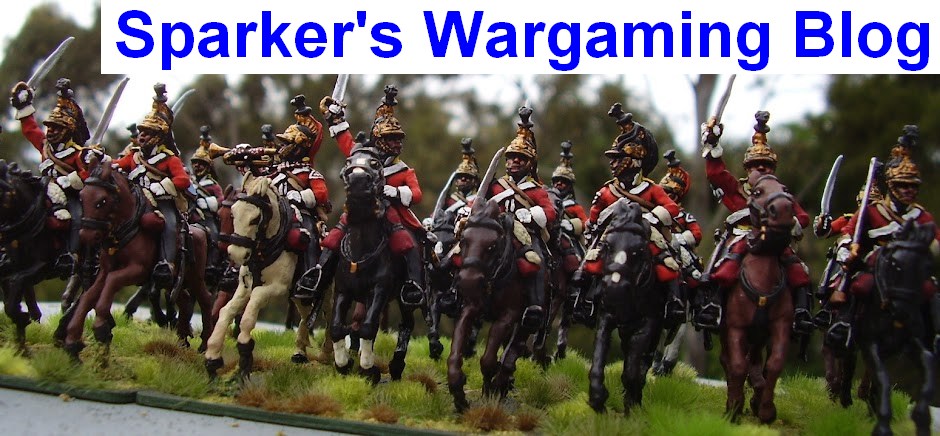Tellnitz was a village on the Austerlitz battlefield of December 1805,

and Philip decided that it would provide a great little scenario for a small and intimate game of Black Powder that he would host for Troy and myself, to take advantage of the fact that Troy, recently posted to Melbourne by the Green Machine, is currently back in the vicinity (by Australian standards of driving, anyway!) So here are some excerpts from Philip’s scenario:

and Philip decided that it would provide a great little scenario for a small and intimate game of Black Powder that he would host for Troy and myself, to take advantage of the fact that Troy, recently posted to Melbourne by the Green Machine, is currently back in the vicinity (by Australian standards of driving, anyway!) So here are some excerpts from Philip’s scenario:
The Battle of Austerlitz - An Unexpected Obstacle at Telnitz (2nd December 1805)
Your Orders – Austrians and Prussians
Austrian and Russian – You have been ordered to roll up the southern flank the French army.
Three columns have been given this task. Keinmeyer’s Austrian Advance Guard is in the fore, closely followed by the Russian 1st Column. Clear Telnitz and cross the Goldbach as quickly as you can to outflank the French army (but not too quickly as you need to wait for the other two columns to catch up…).
Your Orders – French
French – Davout’s Corps is on its way to shore up the southern flank of the French army.
Stall the allied attack for as long as you can and counter-attack wherever possible.
Hold onto Telnitz and keep the allied infantry on the eastern bank of the Goldbach!
Terrain Rules
Telnitz – Three 12” x 12” village blocks.
Note: Alternative rules for fighting in villages are used during this game (see below).
Vineyards and Woods – This terrain can only be entered by infantry units in Skirmish order. Skirmishers are already unclear targets so this terrain does not provide any additional protection.
Goldbach Stream – This is impassable terrain for infantry. Infantry can only cross the stream via the bridges whilst in March Column or Skirmish order. Cavalry can cross this stream, but must stop with rear of unit adjacent to the opposite bank. This is to represent the unit reforming after crossing the cold and fast flowing stream. This will prevent cavalry from charging enemy units across the stream unless they have crossed via one of the bridges in March Column and then reformed into a fighting formation. The cavalry unit is not disordered so can counter-charge if charged in the opposing player’s next turn.
If a units attempts to block a bridge by moving adjacent to the bridge (i.e. so there is no room for the enemy to cross in March Column), then this unit can still be engaged in hand-to-hand combat by an opposing unit that charges into contact with the opposite side of the bridge. The troops are assumed to be fighting on the bridge itself.
Deciding Who Won
The Austrian and Russian player wins if: (1) There are no French units in Telnitz at the end of the game (Turn 12) – Any French unit that is Shaken cannot claim a block; AND (2) More than one Unshaken Austrian / Russian infantry unit (Not Cavalry or Artillery) is on the Western side of the Goldbach Stream at the end of the game (Turn 12).
The French player wins if: (1) At least one block in Telnitz is occupied by an Unshaken French unit at the end of the game (Turn 12); AND (2) There is no more than one Unshaken Austrian / Russian infantry unit (Not Cavalry or Artillery) on the Western side of the Goldbach Stream at the end of the game (Turn 12).
If each player only achieves one of the two objectives, then the game is a draw.
Turn
|
Event
|
1
|
Fog covers battlefield – No long-range artillery fire. (Note: Artillery Ranges are 6’/3’/18”).
Austrian / Russian player has first turn.
Austrian / Russian player may only issue one order to one infantry unit (Not a Brigade order) and this order must be to advance as far as possible towards Telnitz.
At start of French player’s first turn, the Combined Voltigeurs (3rd Infantry Regiment) and Tirailleurs de Po units are placed anywhere within the Vineyards as an immediate ambush.
|
2
|
Fog covers battlefield – No long-range artillery fire.
|
3
|
Fog dissipates at start of Austrian / Russian turn – No further restrictions on artillery fire.
At start of Austrian / Russian turn, reinforcements (1st Brigade from 1st Column) arrive on, and adjacent to, the track at the NE corner of battlefield (Infantry in March Column and Artillery limbered). No unit may be deployed more than 18” from the corner. All reinforcements may be issued an order in this turn as normal.
|
4
|
Normal turn (No special rules).
|
5
|
At start of French turn, the first French reinforcements arrive:
· The Advance Guard Brigade from 3rd Corps arrives on, and adjacent to, the road at SW corner of battlefield in March Column (Light Infantry may be in Skirmish Order). No unit may be deployed more than 18” from the corner. All units may be issued an order in this turn as normal.
· The 1st Dragoon Brigade from 3rd Corps arrives at the centre of the W edge of the battlefield. The rear edge of each unit should be touching the table edge. All units may be issued an order in this turn as normal.
|
6
|
Normal turn (No special rules).
|
7
|
At start of French turn, the second French reinforcements (2nd Infantry Brigade from 3rd Corps) arrives on, and adjacent to, the road at the SW corner of battlefield in March Column. No unit may be deployed more than 18” from the corner. All units may be issued an order in this turn as normal.
|
8-11
|
Normal turn (No special rules).
|
12
|
Game ends at end of French turn.
|
 |
| Saxon Heavies pretending to be Austrian Lights... |
We tossed a coin for who would fight on which side, and it fell out that Troy would be defending for the French, and I would be attacking with the Austrians and, eventually, and I really do mean eventually, the Russian Reinforcements.

My plan was to launch an assault on Tellnitz as soon as possible before Troy was able to bring up his reinforcements, and use my cavalry, pretty useless in taking a village, across the Goldbach to interdict the French Infantry reinforcements as they came on table.

However I knew that, given my low command values, the divorce between plan and reality was likely to come sooner rather than later!
 |
| Leadership - more dynamic on the French side! |
 |
| Austrian Colours flying in Tellnitz! - But for how long? |

With my cavalry having established a bridgehead across the Goldbach, I attempted to despatch the rest of the Austrian infantry across the river to fulfil the second of the victory conditions.

Meanwhile my second Infantry Brigade of Russians, intended to cross the table and invest the far end of the village from the opposite flank, experienced a command blunder just as they were managing to get moving and were forced back 2 moves to where they had entered the table!
Meanwhile Troy was bringing on his fleet footed French infantry reinforcements at a cracking pace, out marching my cavalry to the extent that by the time my horse was in place to attempt to force them into square they were long gone and my cavalry was reduced to attempting to fend off the French Cavalry reinforcements. By this time, my Russians still faffing around far to the rear, Troy committed his French reinforcements to retake the village, which he was able to do with the first assault.

With my original Austrian Brigade suffering considerable casualties from artillery, musketry and skirmisher fire, they were in no condition to attempt to mount a second assault, so my only hope in avoiding defeat was to establish a firm bridgehead across the Goldbach. Here my cavalry fought really well in holding off the heavier French Cavalry, aided by a Russian Horse Battery, and so I was able to consolidate two battalions of Austrian infantry on the far bank, achieving one of the victory conditions for a draw.

A really well thought out scenario from Philip, and thoughtfully adjudicated, producing a game that balanced on a knife edge throughout the game. As we suspected, small games with just 2-3 players who really know the rules can fairly hum along with black powder, and we completed the game in 3 hours in a relaxed fashion.





Nice, looks like a cracking good time! Thanks for posting.
ReplyDeleteAnother great looking game!
ReplyDeleteBeautiful figures and pictures, your village is awesome! A great AAR!
ReplyDeleteBest,
Phil.
Another interesting post with fine eye candy Mr Sparkler. Keep 'em coming please.
ReplyDeleteSalute
von Peter himself
Excellent batrep, sir. Very nice eye-candy
ReplyDeleteGreat looking game Mr Sparker!!
ReplyDeleteI am always impressed by the games you guys put on...loads of figures, fantastic terrain and a good size crew ti play. Well done
ReplyDeleteThanks for all your kind comments gents!
ReplyDeleteSparker once more a great battle and account.I like the changes you made to village combats. It allows attackers to possibly winkle out defenders and then be prone themselves,realistic!
ReplyDeleteMay I ask a few things had the allies nothing to throw into the vineyards to counter the french Legere skirmishing there?
Regarding fighting over bridges i like the attempt to stop gamey units being moved to a bridges edge or riverbank so acting like like a cork in a bottle.But if it does happen, you say both units fight on the bridge using what formation?
Thanks for your comments mate! Regarding the pesky French skirmishers in the vineyards, my plan was to blast them out with artillery - however I had problems with my command rolls to unlimber and move the artillery up to canister range, so it took a while! Hats off to those Legere boys though - they really put a dent in my overall plan!
ReplyDeleteWith the fighting on the bridge, Philip, who designed a scenario, did mention something about it, but I don't recollect exactly as it never came to it. Probably treat both formations as if they were in march column, but allowed to throw 1 combat dice - or similar!
Any chance of getting a hold of your OBAT for the game for both sides, thanks! looks like a fun scenario.
ReplyDelete